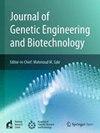Integrative bioinformatics analysis unveils hub transcription factors and their interacting drugs in immunoglobulin A nephropathy: Implications for pathogenesis and treatments
IF 2.8
Q3 Biochemistry, Genetics and Molecular Biology
Journal of Genetic Engineering and Biotechnology
Pub Date : 2025-05-29
DOI:10.1016/j.jgeb.2025.100513
引用次数: 0
Abstract
Introduction
Several studies identified genetic factors and key cellular signaling associated with developing immunoglobulin A nephropathy (IgAN). However, there is still a lack of understanding regarding the relationship between hub-transcription factors (TFs) encoding genes and changes in immunogenic activity. Our objective was to identify hub-TF encoding genes associated with immune cell infiltrations, immunogenic pathway activity, and potential drug candidates in IgAN through bioinformatics techniques.
Methods
We utilized GSE104948, GSE93798, GSE115857, GSE37460, and GSE35487 to identify key significant DEGs and validation in IgAN relative to the control. Next, we employed various bioinformatics approaches to investigate the key genes and their relationship with immunity in IgAN. Finally, we identitified enriched drugs and elcudate their molecular interactions with TFs via molecular docking approaches.
Results
We identified 1,123 differentially expressed genes (DEGs) between IgAN and control samples, comprising 342 upregulated genes and 780 downregulated genes. The upregulated genes are linked to immune-related biological processes and KEGG pathways, while the downregulated genes are associated with metabolic processes. Five significant clusters were identified, enriched in several KEGG pathways. We explored 26 hub-TF encoding genes, including GATA2, HDAC1, TSC22D3, SOX9, RARA, RORA, KLF5, KMT2A, FOSB, and FOSL1, which were consistently dysregulated in IgAN patients. Immunogenic analysis revealed increased levels of Th1 cells, pDCs, monocytes, M2 macrophages, fibroblasts, endothelial cells, and activated dendritic cells in IgAN. The activity of various immunological pathways was also elevated. The expression of hub-TFs like GATA2, HDAC1, TSC22D3, SOX9, RARA, RORA, KLF5, KMT2A, FOSB, and FOSL1 correlated with immune signatures and pathways in IgAN. Additionally, these hub-TFs were linked to diagnostic efficacy and drug interactions. Molecular docking identified key drug candidates for inhibiting HDAC1 and modulating RARA, suggesting their potential for IgAN treatment.
Conclusions
We identified key hub-TFs and their association with immune infiltration and immune pathways linked to IgAN initiation and progression. These findings provide important insights into the immunological mechanisms driving IgAN and propose potential treatment approaches. Molecular docking further revealed key drug candidates for inhibiting and modulating these targets, highlighting their therapeutic potential for IgAN.
综合生物信息学分析揭示了免疫球蛋白A肾病的枢纽转录因子及其相互作用药物:对发病机制和治疗的影响
几项研究确定了与免疫球蛋白A肾病(IgAN)发展相关的遗传因素和关键细胞信号传导。然而,对于中心转录因子(TFs)编码基因与免疫原性活性变化之间的关系仍缺乏了解。我们的目标是通过生物信息学技术鉴定与IgAN中免疫细胞浸润、免疫原性途径活性和潜在候选药物相关的hub-TF编码基因。方法采用GSE104948、GSE93798、GSE115857、GSE37460、GSE35487等基因检测IgAN中关键的显著性基因,并进行对照验证。接下来,我们采用多种生物信息学方法研究IgAN的关键基因及其与免疫的关系。最后,我们鉴定了富集药物,并通过分子对接方法阐明了它们与tf的分子相互作用。结果在IgAN和对照样本中鉴定出1123个差异表达基因(DEGs),其中342个基因上调,780个基因下调。上调的基因与免疫相关的生物学过程和KEGG通路有关,而下调的基因与代谢过程有关。鉴定出5个显著的簇,在几个KEGG通路中富集。我们研究了26个hub-TF编码基因,包括GATA2、HDAC1、TSC22D3、SOX9、RARA、RORA、KLF5、KMT2A、FOSB和FOSL1,这些基因在IgAN患者中持续失调。免疫原分析显示IgAN中Th1细胞、pDCs、单核细胞、M2巨噬细胞、成纤维细胞、内皮细胞和活化的树突状细胞水平升高。各种免疫途径的活性也有所升高。GATA2、HDAC1、TSC22D3、SOX9、RARA、RORA、KLF5、KMT2A、FOSB和FOSL1等hub- tf的表达与IgAN的免疫信号和通路相关。此外,这些中心tf与诊断疗效和药物相互作用有关。分子对接确定了抑制HDAC1和调节RARA的关键候选药物,表明它们具有IgAN治疗的潜力。我们确定了关键中枢- tf及其与IgAN起始和进展相关的免疫浸润和免疫途径的关联。这些发现为IgAN的免疫学机制提供了重要的见解,并提出了潜在的治疗方法。分子对接进一步揭示了抑制和调节这些靶点的关键候选药物,突出了它们对IgAN的治疗潜力。
本文章由计算机程序翻译,如有差异,请以英文原文为准。
求助全文
约1分钟内获得全文
求助全文
来源期刊

Journal of Genetic Engineering and Biotechnology
Biochemistry, Genetics and Molecular Biology-Biotechnology
CiteScore
5.70
自引率
5.70%
发文量
159
审稿时长
16 weeks
期刊介绍:
Journal of genetic engineering and biotechnology is devoted to rapid publication of full-length research papers that leads to significant contribution in advancing knowledge in genetic engineering and biotechnology and provide novel perspectives in this research area. JGEB includes all major themes related to genetic engineering and recombinant DNA. The area of interest of JGEB includes but not restricted to: •Plant genetics •Animal genetics •Bacterial enzymes •Agricultural Biotechnology, •Biochemistry, •Biophysics, •Bioinformatics, •Environmental Biotechnology, •Industrial Biotechnology, •Microbial biotechnology, •Medical Biotechnology, •Bioenergy, Biosafety, •Biosecurity, •Bioethics, •GMOS, •Genomic, •Proteomic JGEB accepts
 求助内容:
求助内容: 应助结果提醒方式:
应助结果提醒方式:


